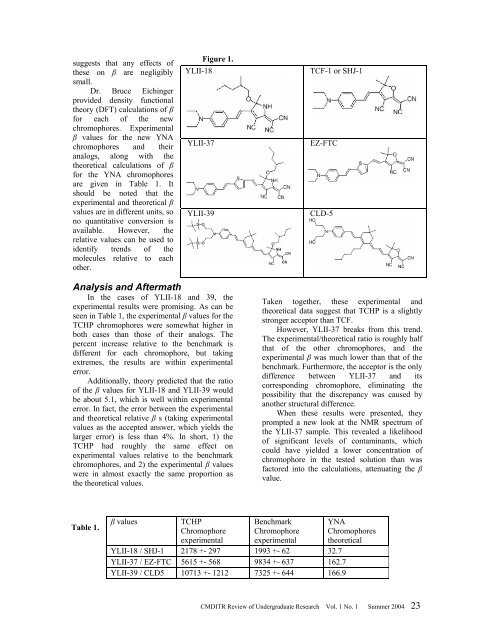CMDITR Review of Undergraduate Research - Pluto - University of ...
CMDITR Review of Undergraduate Research - Pluto - University of ...
CMDITR Review of Undergraduate Research - Pluto - University of ...
You also want an ePaper? Increase the reach of your titles
YUMPU automatically turns print PDFs into web optimized ePapers that Google loves.
suggests that any effects <strong>of</strong><br />
these on β are negligibly<br />
small.<br />
Dr. Bruce Eichinger<br />
provided density functional<br />
theory (DFT) calculations <strong>of</strong> β<br />
for each <strong>of</strong> the new<br />
chromophores. Experimental<br />
β values for the new YNA<br />
chromophores and their<br />
analogs, along with the<br />
theoretical calculations <strong>of</strong> β<br />
for the YNA chromophores<br />
are given in Table 1. It<br />
should be noted that the<br />
experimental and theoretical β<br />
values are in different units, so<br />
no quantitative conversion is<br />
available. However, the<br />
relative values can be used to<br />
identify trends <strong>of</strong> the<br />
molecules relative to each<br />
other.<br />
Figure 1.<br />
YLII-18<br />
YLII-37<br />
YLII-39<br />
TCF-1 or SHJ-1<br />
EZ-FTC<br />
CLD-5<br />
Analysis and Aftermath<br />
In the cases <strong>of</strong> YLII-18 and 39, the<br />
experimental results were promising. As can be<br />
seen in Table 1, the experimental β values for the<br />
TCHP chromophores were somewhat higher in<br />
both cases than those <strong>of</strong> their analogs. The<br />
percent increase relative to the benchmark is<br />
different for each chromophore, but taking<br />
extremes, the results are within experimental<br />
error.<br />
Additionally, theory predicted that the ratio<br />
<strong>of</strong> the β values for YLII-18 and YLII-39 would<br />
be about 5.1, which is well within experimental<br />
error. In fact, the error between the experimental<br />
and theoretical relative β s (taking experimental<br />
values as the accepted answer, which yields the<br />
larger error) is less than 4%. In short, 1) the<br />
TCHP had roughly the same effect on<br />
experimental values relative to the benchmark<br />
chromophores, and 2) the experimental β values<br />
were in almost exactly the same proportion as<br />
the theoretical values.<br />
Taken together, these experimental and<br />
theoretical data suggest that TCHP is a slightly<br />
stronger acceptor than TCF.<br />
However, YLII-37 breaks from this trend.<br />
The experimental/theoretical ratio is roughly half<br />
that <strong>of</strong> the other chromophores, and the<br />
experimental β was much lower than that <strong>of</strong> the<br />
benchmark. Furthermore, the acceptor is the only<br />
difference between YLII-37 and its<br />
corresponding chromophore, eliminating the<br />
possibility that the discrepancy was caused by<br />
another structural difference.<br />
When these results were presented, they<br />
prompted a new look at the NMR spectrum <strong>of</strong><br />
the YLII-37 sample. This revealed a likelihood<br />
<strong>of</strong> significant levels <strong>of</strong> contaminants, which<br />
could have yielded a lower concentration <strong>of</strong><br />
chromophore in the tested solution than was<br />
factored into the calculations, attenuating the β<br />
value.<br />
Table 1.<br />
β values<br />
TCHP<br />
Chromophore<br />
experimental<br />
Benchmark<br />
Chromophore<br />
experimental<br />
YLII-18 / SHJ-1 2178 +- 297 1993 +- 62 32.7<br />
YLII-37 / EZ-FTC 5615 +- 568 9834 +- 637 162.7<br />
YLII-39 / CLD5 10713 +- 1212 7325 +- 644 166.9<br />
YNA<br />
Chromophores<br />
theoretical<br />
<strong>CMDITR</strong> <strong>Review</strong> <strong>of</strong> <strong>Undergraduate</strong> <strong>Research</strong> Vol. 1 No. 1 Summer 2004 23




